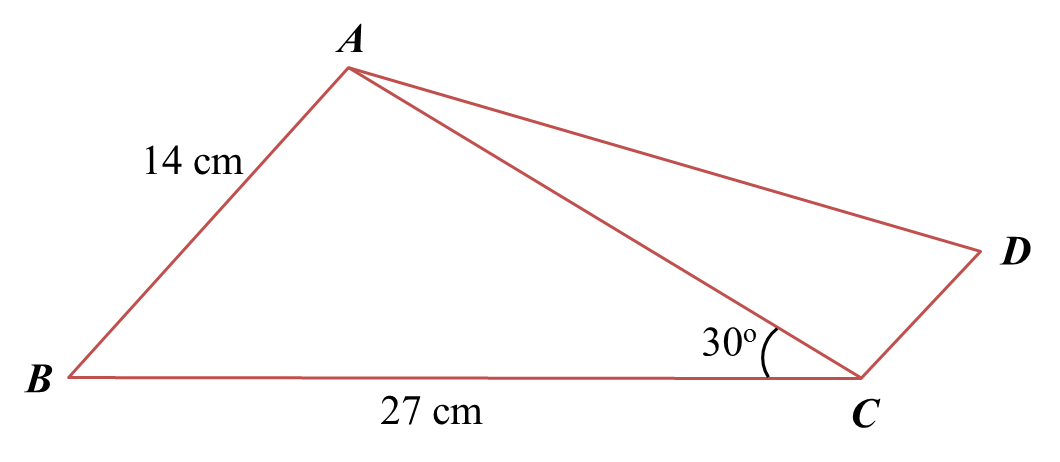Question 7:
Diagram below shows a quadrilateral ABCD where the sides AB and CD are parallel. ∠BAC is an obtuse angle.

Given that AB = 14 cm, BC = 27 cm, ∠ACB = 30o and AB : DC = 7 : 3.
Calculate
(a) ∠BAC.
(b) the length, in cm, of diagonal BD.
(c) the area, in cm2, of quadrilateral ABCD.
Solution:
(a)
sin∠BAC27=sin30o14sin∠BAC=sin30o14×27sin∠BAC=0.9643 ∠BAC=74.64o∠BAC (obtuse)=180o−74.64o =105.36o
(b)
AB parallel with DC∠BAC=∠ACD∠BCD=105.36o+30o =135.36oDCAB=37DC=37×14 cm =6 cmBD2=272+62−2(27)(6)cos∠BCDBD2=765−324cos135.36oBD2=995.54BD=31.55 cm
(c)
∠ABC=180o−30o−105.36o =44.64oAC2=272+142−2(27)(14)cos∠ABCAC2=925−756cos44.64oAC2=387.08AC=19.67 cmArea △ABC=12(14)(27)sin44.64o=132.80 cm2Area △ACD=12(19.67)(6)sin105.36o=56.90 cm2Area of quadrilateral ABCD=132.80+56.90=189.7 cm2
Diagram below shows a quadrilateral ABCD where the sides AB and CD are parallel. ∠BAC is an obtuse angle.

Given that AB = 14 cm, BC = 27 cm, ∠ACB = 30o and AB : DC = 7 : 3.
Calculate
(a) ∠BAC.
(b) the length, in cm, of diagonal BD.
(c) the area, in cm2, of quadrilateral ABCD.
Solution:
(a)
sin∠BAC27=sin30o14sin∠BAC=sin30o14×27sin∠BAC=0.9643 ∠BAC=74.64o∠BAC (obtuse)=180o−74.64o =105.36o
(b)
AB parallel with DC∠BAC=∠ACD∠BCD=105.36o+30o =135.36oDCAB=37DC=37×14 cm =6 cmBD2=272+62−2(27)(6)cos∠BCDBD2=765−324cos135.36oBD2=995.54BD=31.55 cm
(c)
∠ABC=180o−30o−105.36o =44.64oAC2=272+142−2(27)(14)cos∠ABCAC2=925−756cos44.64oAC2=387.08AC=19.67 cmArea △ABC=12(14)(27)sin44.64o=132.80 cm2Area △ACD=12(19.67)(6)sin105.36o=56.90 cm2Area of quadrilateral ABCD=132.80+56.90=189.7 cm2